This video was made to accompany the blog, it has all the pictures included in the blog. Backing track All Angels.
Yesterday (18/08/2012) while browsing in a Charity Shop, this book literally jumped out at me, it is a hard back copy of a Book about Jerusalem.
The pictures in this book tell a story of three of the Worlds
most prevalent religions, which are all rooted in this ancient city. Islam,
Christianity and Judaism all claim ancestry from this City.
These amazing pictures were taken during the 1960’s, they
capture moments in time that I felt should be available on line. The
historical, religious and political interest in Jerusalem is Universal, because
of my own personal appreciation of these pictures, I felt others would also
appreciate them, so I have dedicated a whole day to scanning them and making
them available on line. My scanner is ancient in PC terms, and it is attached
to my equally prehistoric PC, so scanning them to file was a laborious process.
This blog is not about my personal religious or political beliefs;
it is merely to make these images available on line. All commentary will be
taken from the book unless otherwise stated.
The book was published in 1969 by Heinemann, then in 1976 by
Time Life Book’s, the Author is an Englishman called Colin Thubron, and the
photographer Jay Maisel, a native of New York. Both author and photographer
strived to document the city and its inhabitants without prejudice.
1. The City of Earth and Heaven
Christian symbols of cross, thorns and chalice in Dominus Flevit
church overlook one of Islam’s greatest shrines, the Golden Dome of the Rock.
The Dome itself stands on the site of the Temples of Solomon and Herod, sacred
in the memory of the Jews.
Although the three religions differ radically, they all venerate
the Patriarch who broke from the worship of many Gods to focus on one God
alone.
A trick of the light on a misty winter’s day trims sprawling Jerusalem to the proportions of the Old walled city.
(left) An Arab Pedlar
The realm of Biblical seers and prophets, the eroded Judean Hills to the East of Jerusalem stretch to the horizon in parched desolation.
This is the so called Wilderness where John the Baptist preached, and Jesus came to fast and meditate for 40 days and 40 nights.
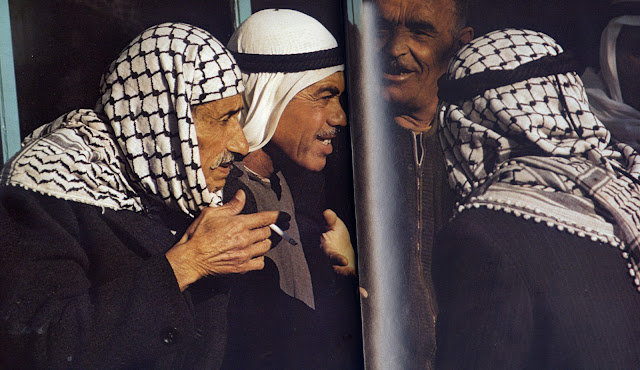 |
Joined by the patron (centre) outside his café, men wearing
kaffiyehs sit in the sunshine and shade and indulge an Arab passion: animated
conversations.
|
 |
Two Muslim women stroll along El-Wad, another of the Old Cities
thoroughfares. They are veiled in strict adherence to Muslim orthodoxy.
|
Bending beneath his sombre load, a porter carries a coffin of
rough boards, its lid ominously agape. Its destination: A Christian dwelling,
where a man has died.

 |
 |
Shielded from the late sun by a café’s half-lowered shutter, two
young Arabs study their newspaper.
|
 |
Two intense Café customers pursue a conversation, seemingly
unaware of their Spartan surroundings.
|
 |
In a quiet corner an elderly Arab reflectively smokes his
narghile, or water pipe. Local tobacco is employed, sometimes combined with a
little hashish.
|
 |
A solitary Orthodox Jew, picked out by a light of dawn, walks
through a still shuttered Muslim Street on his way to pray at the wailing wall.
|
 |
| A low tunnel dug by Jebusites more than 3,000 years ago, leads away into the dark interior of Mt Ophel from the underground spring of Gihon. Threatened by Assyrian conquest in the 8th Century |
 |
A wall of
Grief and Joy.
Written
prayers tucked into crevices in the stones of the wall are thought by those who
place them there to carry their messages straight to God.
|
After
finishing their service one group starts a joyful dance while others still pray
at the wall. The woven screen separates the men from the women.
 |
At the wall,
adults fasten straps holding a phylactery (a prayer box) to a boy’s arm during
a bar mitzvah.
|
 |
Awed by the
rite, the 13 year old wears on his brow a phylactery containing Old Testament
verses.
|
Survivors of Herod’s day, The stables of Solomon were misnamed by the Crusaders who kept their horses here. The piers and vaults still support a broad esplanade, once part of Herod’s Temple complex.
 |
An Arab
girl, incongruously clad in gold lame dress keeps a attentive watch over her
Father’s flock.
|
 |
Six bullion
domes poke into the mist blanketing the grounds of the convent church of St
Mary Magdalene near the Garden of Gethsemane.
|
 |
In the
convent of St Mary Magdalene at Gethsemane there are three elderly Russian Nuns
who busy themselves painting icons.
|
Keeping watch over the site of Christ’s tomb, in the church of
the Holy Sepulchre is an icon of the Virgin Mary. Her face and hand have been
blackened and effected by age the heat and soot of the candles and the kisses
of Pilgrims.
Led by Franciscans, the procession of Pilgrims that sets out every
Friday to retrace Christ’s steps to Calvary halts for prayers (aided by a
microphone), at the seventh station of the cross.
The washing of Jesus’s body after it was taken from the cross, an event that according to belief took place on this spot.
Votive lamps suspended above Christ's tomb by various sects suggest the crowded conditions prevalent in the church of the Holy Sepulchre.
The
Franciscan order, reputedly established in the Holy Land when St. Francis
travelled there in 1219, has been the chief representative of the Roman Church
in Jerusalem ever since the Crusader period.
Dimly lit, a
modern mosaic of the Crucifixion rises sombrely – and symbolically – behind the
altar of the Franciscan Chapel on the side of Calvary.
The simple
Franciscan Chapel of Calvary inside the Church of the Holy Sepulchre stands on
the spot where the Crucifixion is believed to have taken place.
Only a few feet from the plain Franciscan chapel, a blaze of candlelight shed a golden lustre on the Orthodox Chapel of Calvary.
An archway
through which Jesus is supposed to have passed through as he carried the cross
to Calvary.
The Armenians
Armenian
Christians have been in Jerusalem for over 1,500 years. Like the Eastern
Orthodox and Roman Catholics, they have secure rights in the church of the Holy
Sepulchre.
Choir,
congregation and hooded clergy celebrate the liturgy in the huge Church of Saint
James, rich with lamps, wall tiles and fine carpets.
Unmistakable in their pointed hoods, Armenian Monks pass by a grille.
The Ethiopians
In the
vicissitudes of its history the small but ancient Ethiopian, or Abyssinian,
sect has lost most of the rights of possession it once had in the church of the
Holy Sepulchre. The Monks now live a humble, contemplative life on the roof of
the chapel of Saint Helen, stubbornly guarding their privileges against the
rival claims of neighbouring copts.
On the roof
of the Holy Sepulchre, interlocking walls and arches of different periods give
the Ethiopian Monks a small complex world of their own.
END OF PART 1
LINK Part 2
Sandra Barr











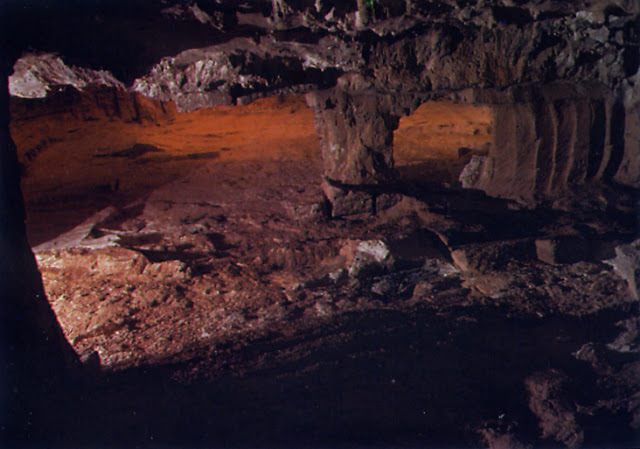







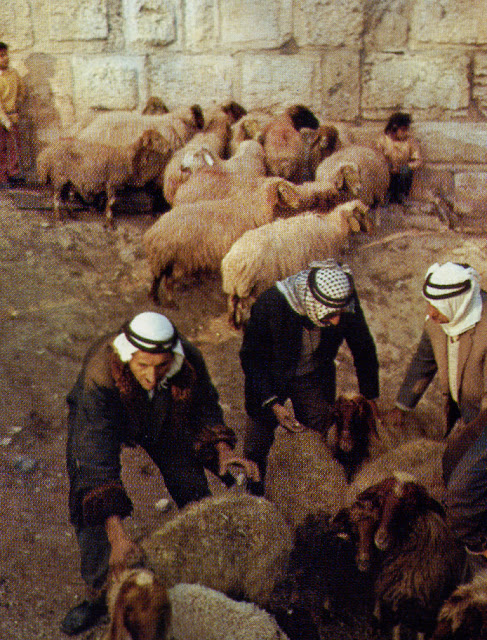





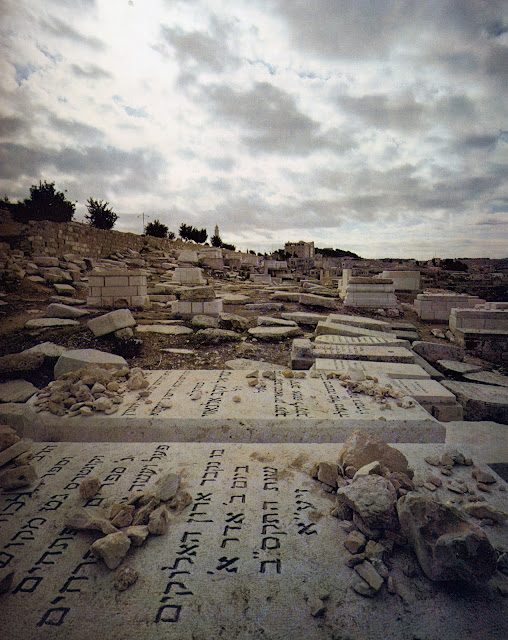









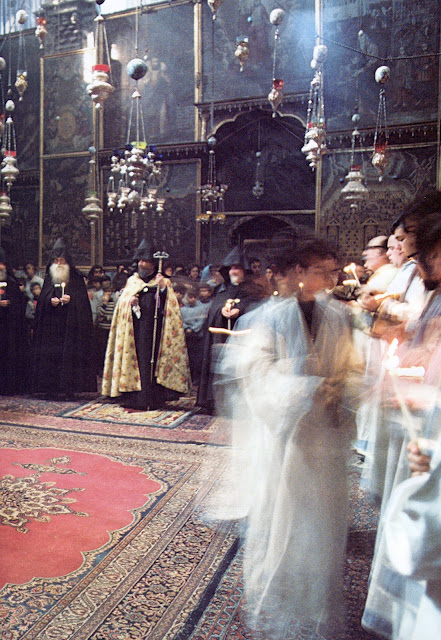












Thank you so beautiful and peaceful.
ReplyDelete